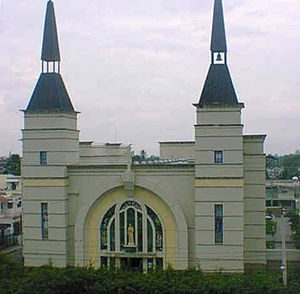 Catedral Santa Ana, San Francisco de Macoris, Dominican Republic (where I have found records on my father-in-law’s ancestors back to 1822). Courtesy of Wikipedia.org
Catedral Santa Ana, San Francisco de Macoris, Dominican Republic (where I have found records on my father-in-law’s ancestors back to 1822). Courtesy of Wikipedia.org
Following up on a post by David Allen Lambert on the question of identity, a semi-related topic involves the generation in the United States to which someone belongs. In my experience, this might mean something different for a genealogist belonging to a family long resident in America, as opposed to the child or grandchild of a recent immigrant.
My most recent immigrant ancestors were my great-great-great-grandparents Joseph Kelly and Rebecca Nelson, who came over from Ireland to Philadelphia in the 1840s and married there in 1850. Through that part of my ancestry, I would call myself sixth generation. I count Joseph and Rebecca as the first generation, and would describe it in a genealogy as follows:
Christopher Challender6 Child (William Chapin5 Child, Elizabeth Peltz4 Helman, Mazy Nelson3 Kelly, Thomas Nelson2, Joseph1)
Through my various German ancestors I am anywhere from eighth to tenth generation:
Christopher Challender9 Child (William Chapin8 Child, Elizabeth Peltz7 Helman, Gilbert Wayne6, Herbert Heath5, William Thomas4, Michael3-2, Jacob1-A)
Then going back to my colonial New England ancestry, I am anywhere from eleventh to fifteenth generation:
Christopher Challender12 Child (William Chapin11, Henry Thurston10, William Chapin9, Henry Thurston8, Asa Thurston7, Luther6, Willard5, Henry4, Ephraim3, Benjamin2-A, WolstoneB)
Christopher Challender15 Child (Joy Dolores14 Challender, Willard Alton13 Challender, Elizabeth Belle12 Severance, Willard Lorenzo11 Severance, Marion P.10 Botsford, Lydia M.9 Franklin, Esther8 Daggett, Reuben7 Daggett, Isabel6 Round, Renew5 Carpenter, Desire4 Martin, Mary3 Billington, Francis2, John1)
Different published genealogies (such as the Mayflower Families Through Five Generations Project) may use slightly different ways to summarize the generations and where the superscripted generation number goes in relation to the surname. In my examples above, I consider the first generation that lived in the United States number 1, and an A or B generation denotes people who never emigrated (A being the father of the immigrant, B the grandfather etc.).
Also, when the name is the same for two or more generations, I “connect” the generations for that name, such as the above three Benjamin Childs going from 2 to 1 to A; other genealogists may choose to name each of the three Benjamins separately. In the examples above, for the first three, the “1” generation is the only immigrant born abroad, while their sons were born in the United States. For the last example, both John and Francis Billington were born in England and came together on the Mayflower in 1620. Since the father and son both lived here, John is 1 while Francis is 2.
However, when discussing this system with my wife and several friends who are the children of immigrants, I find they tend to identify themselves as “first generation,” as they are the first generation born in the United States or were raised in the United States for most of their lives. My wife, for example, was born in New York City in 1982. Her parents had both emigrated separately from the Dominican Republic in the 1970s and met in New York. On her mother’s side, if I were writing a genealogy, I would call my wife the second generation:
Arlene2 Ovalle (Claudia Maria1 Paulino, Juan AntonioA, Francisco IsidoroB, Jose ValentinC, GeronimoD)
However, it’s a little a tricky on her father’s side. While he immigrated on his own, his father also immigrated to New York (alone) and died there in 1986. Decades later, his wife (my father-in-law’s mother) also settled permanently in the United States. Also, after my wife was born, she lived with her mother in the Dominican Republic for several years before returning to New York. Even though they each have their unique immigration experience, if this were a genealogy, I would consider my wife the third generation paternally:
Arlene3 Ovalle (Jose Amado2, Severo1, EsmeraldoA-B)
Of course, this is only counting generations in the United States. Both of the above Paulino and Ovalle families (in part based on Y-DNA results from my father-in-law and mother-in-law’s brother), ultimately descend agnately from Spanish immigrants to the Caribbean, although the few generations I have traced are still in the Dominican Republic. In that case my wife could also be anywhere from tenth to fifteenth (or even higher) generation “American” in terms of immigration to the American continents![1]
How one identifies oneself in relation to a family’s history in America (in these cases) is a personal question, but the above examples make sense to me when preparing a genealogy with an American theme.
Note
[1] My wife’s autosomal DNA results have identified her as 66.2% European, 19.9% Sub-Saharan African, 9.4% East Asian & Native-American, 1.7% Middle Eastern & North African, and 2.9% Unassigned. For her indigenous ancestry, the number of generations on this continent could be quite numerous!
Share this:
About Christopher C. Child
Chris Child has worked for various departments at NEHGS since 1997 and became a full-time employee in July 2003. He has been a member of NEHGS since the age of eleven. He has written several articles in American Ancestors, The New England Historical and Genealogical Register, and The Mayflower Descendant. He is the co-editor of The Ancestry of Catherine Middleton (NEHGS, 2011), co-author of The Descendants of Judge John Lowell of Newburyport, Massachusetts (Newbury Street Press, 2011) and Ancestors and Descendants of George Rufus and Alice Nelson Pratt (Newbury Street Press, 2013), and author of The Nelson Family of Rowley, Massachusetts (Newbury Street Press, 2014). Chris holds a B.A. in history from Drew University in Madison, New Jersey.View all posts by Christopher C. Child →